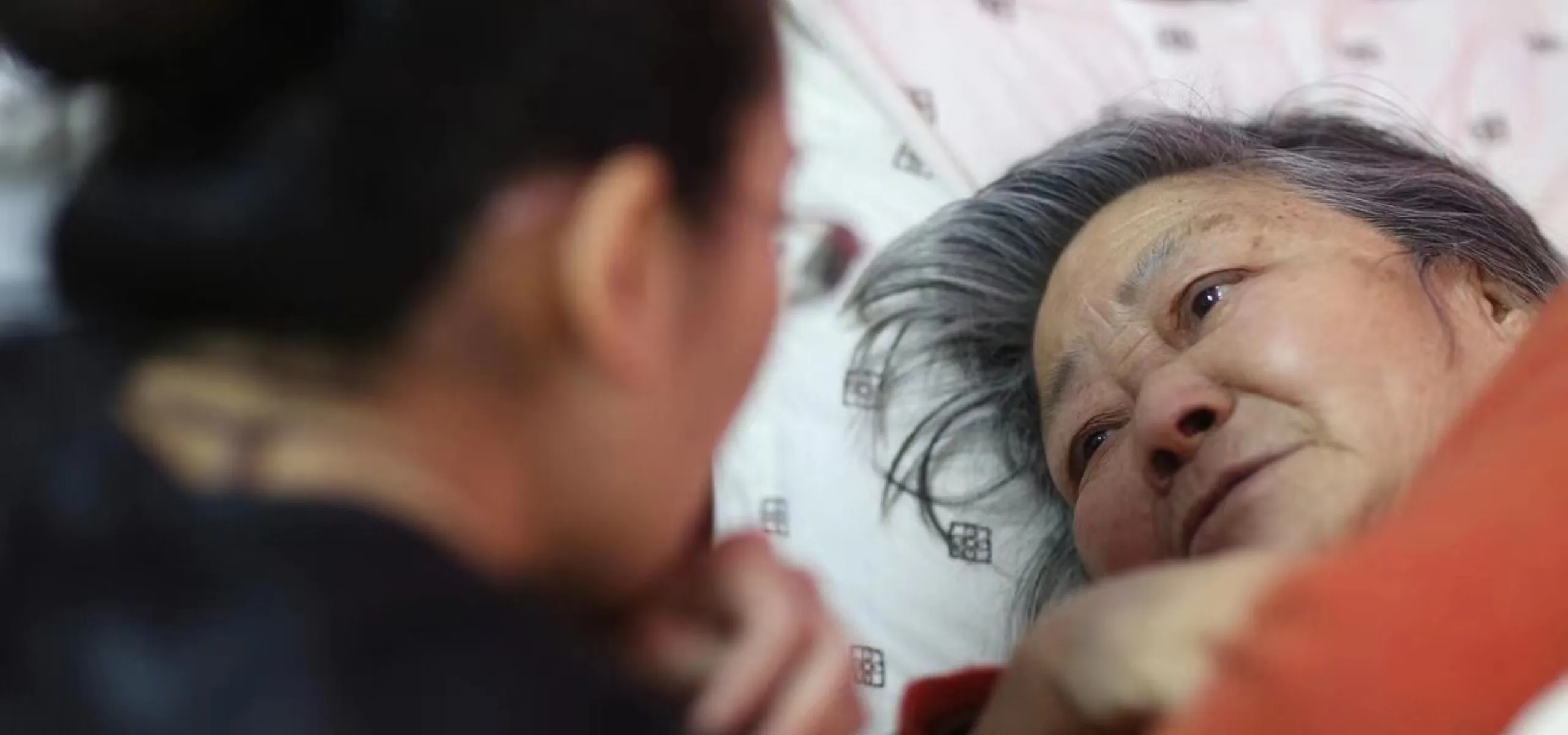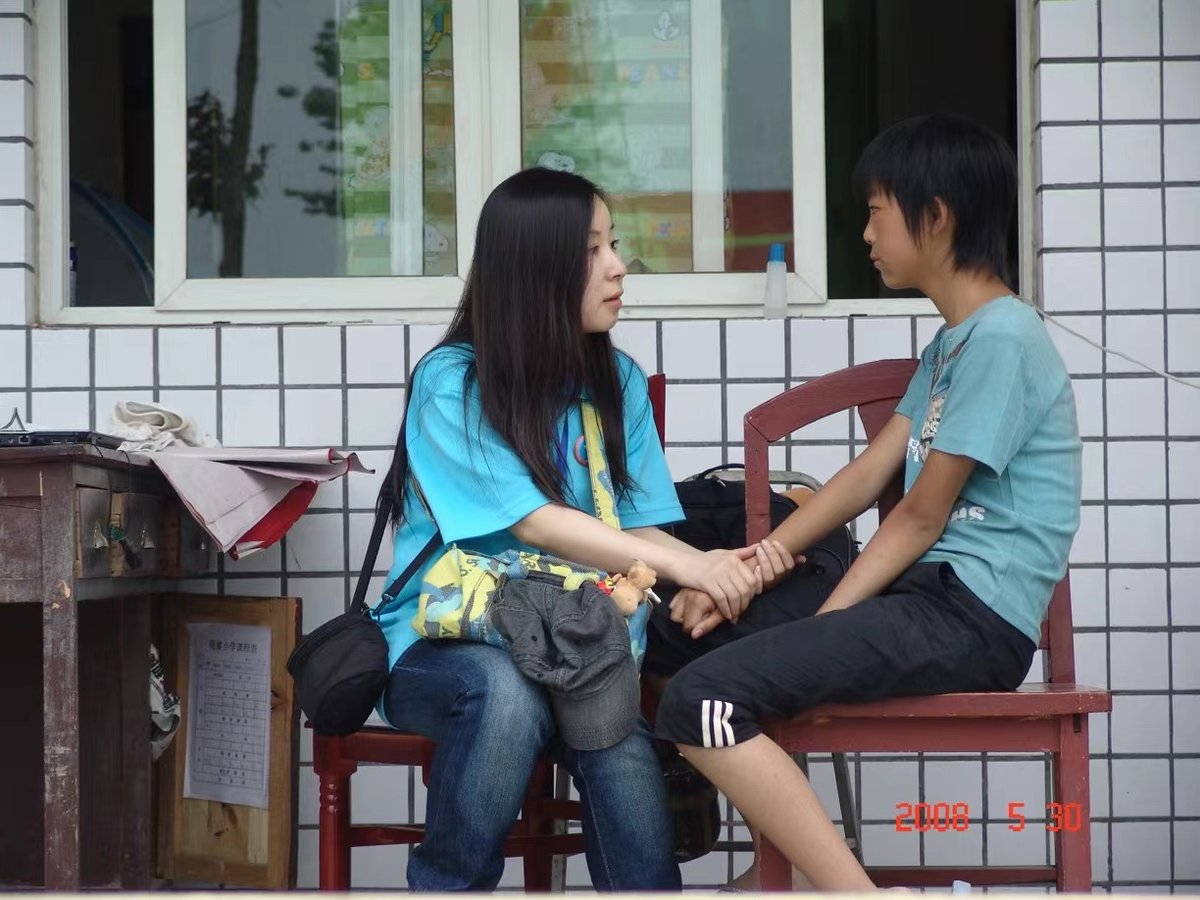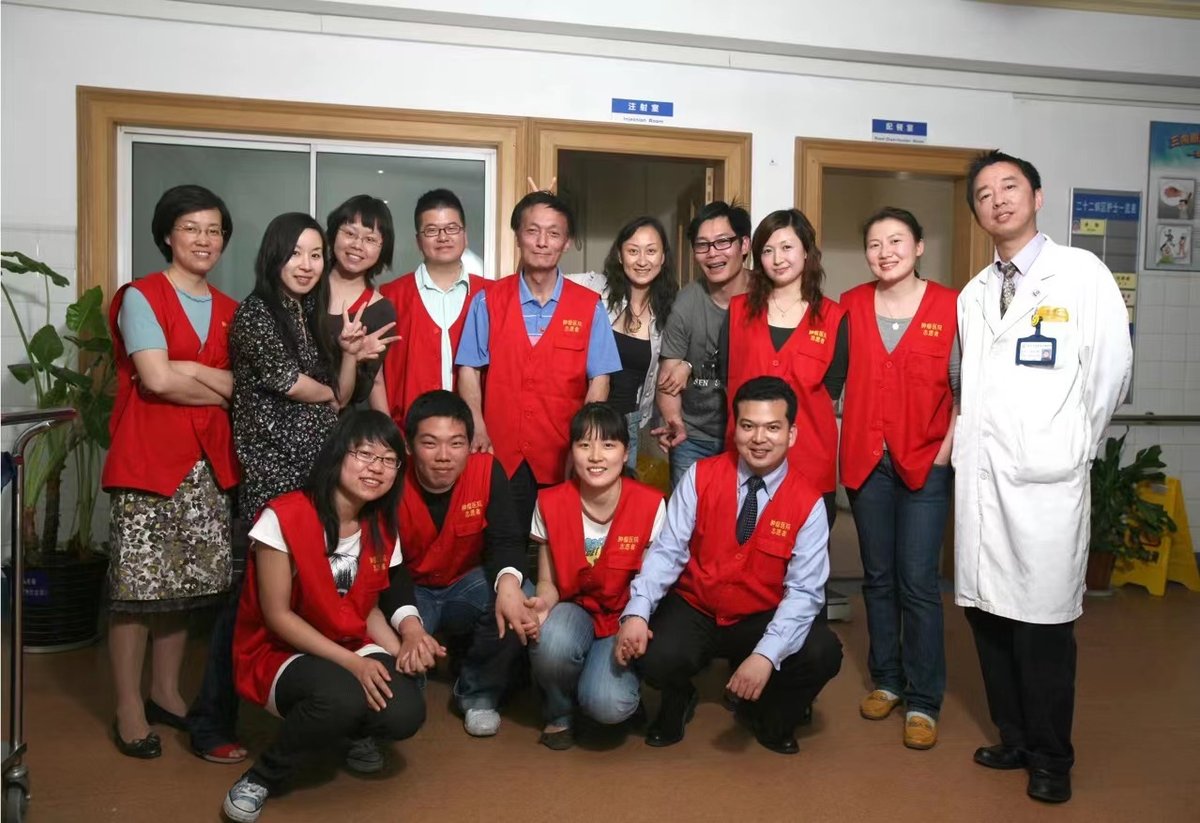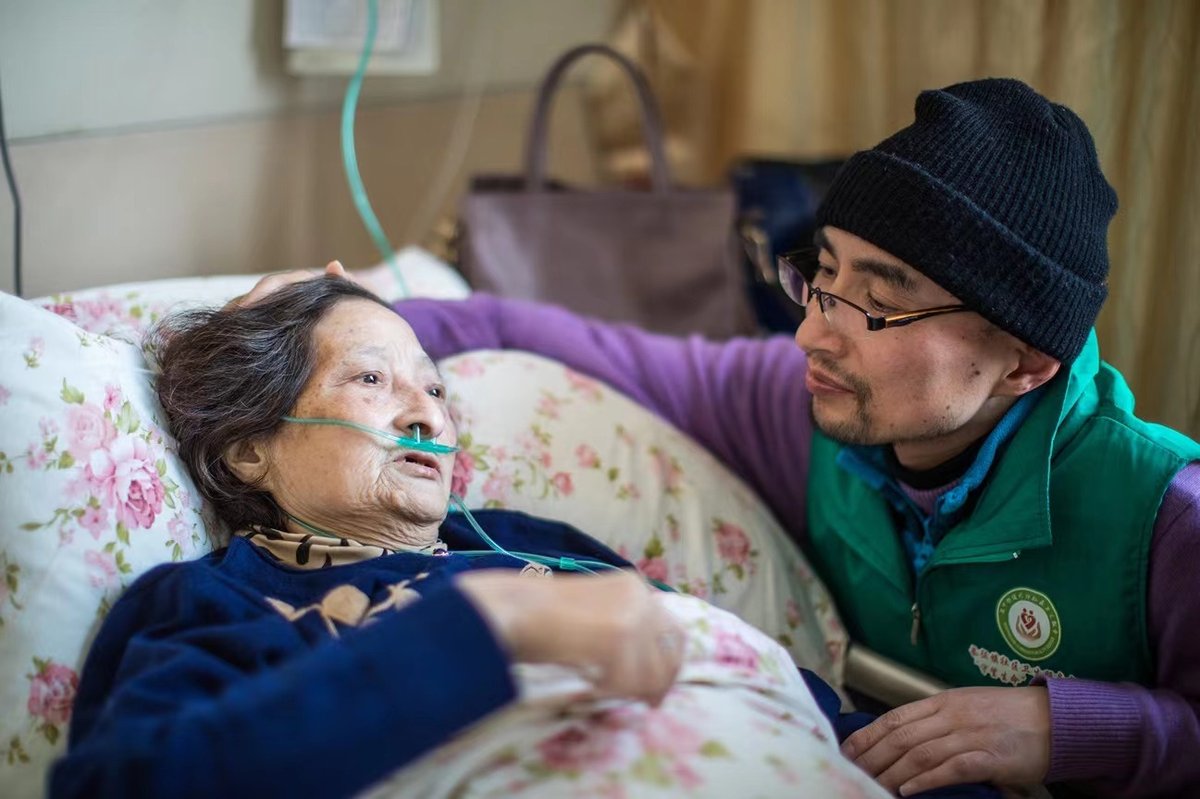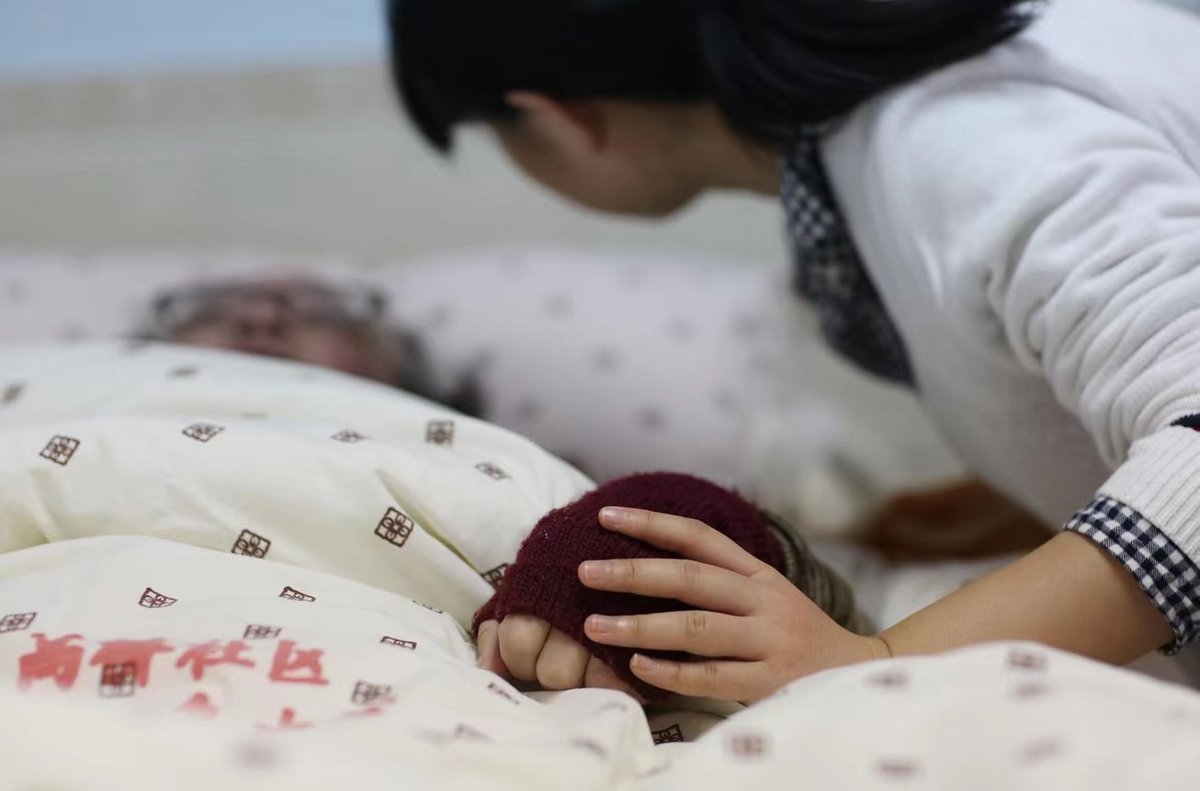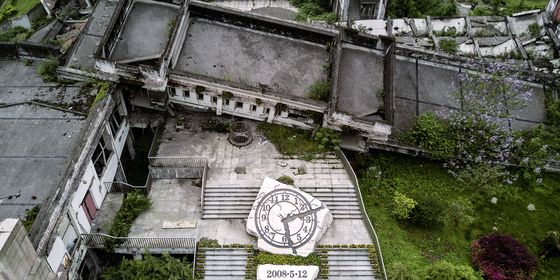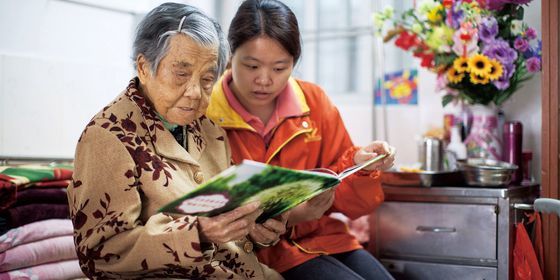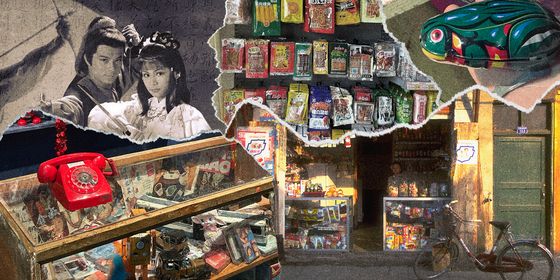NGO founder Wang Ying shares what’s ailing palliative care in China, plus her own battle with cancer
On May 12, 2008, the Wenchuan Earthquake, also known as the Great Sichuan Earthquake, killed nearly 70,000 people, injuring over 39,000 and leaving nearly 18,000 missing. The rescue missions in the aftermath of the quake were a test for China’s fledgling mental health sector, which deployed systematic psychological aid to the disaster area in northern Sichuan province for the first time in its history. One of the frontline psychiatric aid volunteers was a woman called Wang Ying.
Prior to 2008, Wang had actually worked in the advertising industry. She then became interested in psychology, studying at East China Normal University, and eventually became a psychological counselor. That’s also where she met Huang Weiping, who would become her husband as well as her partner in founding the Shanghai Hand in Hand Life Care Development Center.
In fact, 2008 also went down in history as an important year for the public welfare sector, with many nonprofit organizations set up right around that time. After the earthquake, Wang and Huang joined forces with fellow students to set up a psychiatric aid volunteer group to assist those stricken by tragedy. After returning from Sichuan, they decided to keep the group running, helping elderly patients facing the end of their lives at community hospitals around Shanghai. Today, Wang shares with us her experiences in the wards, the state of hospice care in China, and what her own brush with cancer taught her about living and dying.
1
How I Got Acquainted with End-of-Life Care
Wang Ying: At the time we returned from the Great Sichuan Earthquake, a member of our team told us that there was a terminal ward at the Fudan University Shanghai Cancer Center, also known as Shanghai Cancer Hospital, where the life expectancy for patients didn’t usually stretch beyond one and a half months. As you may imagine, that was a rather bleak atmosphere. Our team member contacted chief Dr. Cheng Wenwu, a man eager to go the extra mile for the patients’ families. Eventually, we paid him a visit at the hospital. Back then, his ward was known as the Department of Palliative Care, admitting patients with late-stage cancer to try and provide them and their families with hospice care in the last days of their lives. I was really moved by this whole premise.
Dr. Cheng revealed to us that the hospital’s resources were far from sufficient to serve the entire city of Shanghai. In 2008 alone, many terminal cancer patients simply could not be admitted to the ward. Those who were not lucky enough to end their days under his team’s care were either sent to the emergency room or straight home. Even those who had the means could only stay in the hospital for around two weeks.
Imagine how a person who is facing the end of their life must feel to be tossed around from place to place this way, along with their relatives. Dr. Cheng counted a meager total of fewer than 60 terminal care hospital beds versus an estimated 28,000 people who’d succumbed to cancer in Shanghai just in that period of time.
2
Sixty Beds in a City of Millions
Dr. Cheng Wenwu’s own experience with palliative care traces back to 2005, when he started his service at Fudan University Shanghai Cancer Center, a pioneer healthcare institution among the nation’s top three units devoted entirely to palliative care.
Palliative care, also known as hospice care, is a term that refers to the provision of physical, psychological, spiritual, and humane care for terminally ill or elderly patients in their final days, including enabling them to die comfortably, peacefully, and with dignity.
In fact, hospice care was already a reality on the Chinese mainland in the 1990s, with over 200 hospitals providing such services. However, this pool of resources gradually shrunk over the years due to a series of reasons, such as the market-oriented hospital reform. That’s how you arrive at the dismal figure I just mentioned before—fewer than 60 hospital beds assigned to hospice care in 2018 for a city of millions like Shanghai.
Given that palliative care is indeed rooted in medical care, it only makes sense that hospitals should be at the forefront of hospice services. However, the reality is that these health care institutions are underpowered in this regard. On one hand, this is due to hospitals’ undeniable need to survive, with hospice care draining their resources and requiring significant investment with fairly limited returns. It’s simply not cost-effective. On the other hand, hospitals are understaffed when it comes to hospice care—most medical staff remain fixated on the premise of curing diseases and saving their patients’ lives. Attention remains focused on patients who can recover from their ailments. These healthcare professionals lack motivation to tend for incurable patients. For those who are actually willing to step in, such as Dr. Cheng, they’re left in a vulnerable situation where they’re forced to depend on external help, like our organization, to carry out their responsibilities.
Let’s look at the situation in Taiwan, for instance. Major hospitals there need to form a team of at least 30 social workers before they can expand their inpatient services to a wider, outpatient scale. They will assess the demand and integrate social resources into the services they offer.
But, that’s not how it works in our top hospitals on the mainland. Here, it’s already considered a success if a hospital manages to put together a five-member social work department. On average, major hospitals here only usually have one or two social workers. Therefore, they rely on the support of external NGOs with their own volunteer teams.
Dr. Cheng established his department at what was then Fudan University Cancer Hospital in 2005. By then, he’d spent three years on duty without ever receiving any resources to support his work. That’s when my then-boyfriend and Hand in Hand co-founder, Huang Weiping, shook hands with Dr. Cheng on our commitment to his cause, “OK, we’re in this with you for the next three years.”
And so our journey began.
3
Our First Patients
When I entered the hospital ward, I found it different from our previous experiences. As psychological counselors, we tend to place great emphasis on the patient’s initiative to seek our services. However, in the hospital ward we quickly found that nobody came to us. To begin with, patients didn’t really understand the concept of a volunteer in this context. Even if they knew, they didn’t know just what they wanted you to do. We weren’t doctors or nurses—why on earth should they seek our help?
So initially, we were invariably met with rejection. In fact, some people thought we were salespeople. We’d show up at their door and they’d immediately turn us down before we could even say a word.
I still remember my first day in the ward. At first, I’d approached this female patient who was only in her 40s, even if she looked 60 and her hair was all gray due to the treatment she’d undergone. However, she turned me down repeatedly.
Her roommate on the next bed over had accepted our services, though. Once, I went to their room looking for him, only to find an empty bed. The middle-aged lady gave me a look and said that the man had been wheeled away for a CT scan. I thanked her for the information and was about to leave when it suddenly occurred to me that I could give it one final try since she happened to be alone in the room.
That time, I managed to introduce myself as a public welfare volunteer. “Let’s have a chat, if you’d like?” She seemed to give it some thought and then said, “OK.” Later I learned that the real reason she’d accepted our services this time was because her condition had worsened.
There was more to this patient than met the eye. She was a widowed mother of one—her husband had passed away unexpectedly when she was pregnant with their child. At the time, some people advised her to get an abortion, but she refused. She never remarried and simply raised the boy on her own.
The child was in his third year of junior high by then. Every day after school, he went to the hospital, did his homework there, and ate with his mom before going home alone. This made us adjust the time of our visits to the evening. The woman said that her son had never spoken much during his one-on-one time with her, not until our arrival. Our presence there somehow managed to make him truly open up.
On this note, let me pause this story for a bit. Another case from back then just came to my mind. There was a family of three that never did use our volunteer service. Here, the mother was an inpatient too, but her child was older. Every time he visited, he’d sit on the opposite side of the bed with his eyes glued to his mobile phone. He never talked to his mother. This went on until she eventually passed away and the impact of her death finally struck her now-orphaned son. He resorted to self-harm as the only way he seemingly knew to process his pain, hitting his head against a wall in the ward until he drew blood.
We felt that the contrast between the two sets of mother and son was really apparent.
Back to the first lady. Eventually she was far too sick to ever be discharged from the hospital. However, she missed her son dearly. We came up with a suggestion—we could accompany her son to their family home to film a day-in-the-life video that we would then present as a surprise for this ailing mother. Her son agreed, and so one day we went to their home with a digital video camera.
As it turned out, they lived in a tiny space in an old-fashioned shikumen “lane house" in Shanghai. The place actually housed many other families, and this mother and son’s living space barely amounted to 10 square meters. The boy slept on a bottom bunk, while she had used the top bunk. The room was really dark, and the walls were lined with the kid’s school awards and idol posters.
Some neighbors happened to be walking past or playing mahjong nearby when we first arrived there, so we featured them in our video. They all said that they hadn’t imagined the woman would be in such poor health, and pledged to help take care of her son so that she wouldn’t have to worry.
As a matter of fact, we didn’t know how to edit the footage, so we just made it all into a CD for the mother. Later, her kid told us that she really liked getting a glimpse of the mahjong games, as that had been her favorite pastime. Those good old days were now over, but the CD still brought her a lot of joy.
She passed away not long after that, on a day when we happened to be away from the hospital. The kid’s grandmother informed us of her death.
Shortly before her passing, we had asked her what was her biggest wish. She then replied, “I’d love to just go home and cook a meal for my son.”
We were all so touched. When people die, they couldn’t care less about fame and fortune. Instead, they long for just one last happy memory with their loved ones, a chance to do something for them before departing this world.
Anyway, this is how Hand in Hand came to be in 2008. In 2009, we were officially registered as an NGO with the support of the local civil affairs system. With this step, we became the first full-fledged nonprofit organization on the Chinese mainland to provide hospice care services.
We recruit, screen, and train volunteers from civil society, sending them to hospitals where they may provide their services in the context of hospice care. Before the pandemic, we honored our NGO’s name by working hand in hand with 11 hospitals in Shanghai to provide a three-pronged service to patients.
Firstly, we carry out what we call buddy visits. Volunteers are matched with a patient. From then on, they’ll provide basic companionship to their patient. Then, once a month we host ward activities where the patients can visit one another, talk together, and even exercise. These activities are also open to the patients’ relatives, as well as doctors, nurses, and other ward staff. The goal here is to create a feeling of community and togetherness. Last but not least, we offer patients and families the chance to make a wish.
4
The Man With No Visitors
We once served a man who was said to be on his own, without any relative ever coming to visit him.
At least that was the doctor’s understanding. His was a strange case—he had actually come to the hospital on his own, and alone he remained at all times in the ward. Nobody could even recall anyone ever coming to the hospital to pay his inpatient fees. He’d made the first payment himself, then the rest followed by bank transfer. What an unlucky patient, the doctor concluded. Maybe his family relationships were in shambles; maybe he was a bachelor. Either way, we formed a group to communicate with him.
On my first visit to him, I saw him as a rail-thin man with darkened skin. However, he was actually still only in his early 40s and in good spirits. We talked for a bit and I found out that he actually had an older sister who did visit him twice a week—we simply hadn’t met her because our service time is always scheduled for the weekends, while she came over in the evening on weekdays. And he was no bachelor; he had a wife and a son.
However, this only raised more questions—if there was indeed a family in the picture, why didn’t they ever come to visit? After some discussion, we decided to get in touch with his sister first to try and understand their family dynamics.
Things didn’t go as we expected. The man’s sister made no effort to hide her anger upon hearing that no other relative ever came to visit. “Nobody, not even his wife?” Seeing that she was ready to go confront her sister-in-law, we immediately got in touch with the man’s wife.
She was defensive at the beginning. I introduced our organization to her and tried to inquire whether she’d encountered any difficulties. We only got her to reply that she was very busy, but she’d visit her husband that very same day. We decided to be present, too.
When we arrived at his hospital room, the man’s wife was indeed standing by the bed. Though they did exchange some words, it was obvious that communication between the couple was fairly sparse. After a little while, she announced she was leaving, so I went out with her.
“You know,” I tentatively said, “he was very happy when he learned of your visit, and he really perked up afterward.” She replied that her husband’s five-year battle against cancer had pretty much depleted the family’s savings. She was now the sole breadwinner of the household, and her boss was not helping her case. He was an extremely superstitious man without any empathy. He was even known for swearing at whoever was unlucky enough to have to ask for sick leave, whether for themselves or for any family member.
“It’s not like I have any options,” she disclosed. “If my boss knew that my husband is on his deathbed, he’d just fire me immediately, and what would I do then? I’d be left without any income.” Their kid was a senior in high school, and she had yet another dependent—her mother, who was suffering from glaucoma. This woman spent the day at work before going back home to resume her caregiver duties. The way things were, she had to rush through her hospital visits, with just a stop at the bank and a mere moment to spare at her husband’s room.
We shared this all with the man’s sister, who fell silent for a while. She then broke her silence to say that she never imagined her sister-in-law was facing such difficulties.
And there was even more to learn. This man was highly regarded in his own company; his sister disclosed that he was practically a co-founder.
I wondered whether I could get a few of the man’s colleagues to visit him at the hospital. Eventually, a small group of us went to his company to arrange everything.
The boss there was rather surprised. Though he did know the man was sick, he didn’t expect it to be so serious. He gathered all the employees—some 70 or 80 people—in a large room where we were welcomed with applause onstage. We explained to everyone the situation of their former coworker and brought out a video camera to record a short message from those colleagues who wouldn’t be able to make it to the hospital themselves.
All in all, we spent some three hours at the company, and everyone had a message for this man, even new employees who’d never met him. I remember one of them saying, “Though we’ve never met, I’ve heard about you and your contribution to the company through others, and I think you’re amazing.”
Needless to say, we saved all these kind words in a CD for the man to watch and enjoy, but the goodwill of his employees didn’t stop there. His company’s boss set up a series of recurring donations for his family to support them all through their time of need, and his colleagues established shifts to visit him every few days.
The man was so excited, he couldn’t sleep at night. He watched his CD over and over, and eventually revealed his wish to us. He’d promised his kid that he’d be there to see him walk into the building when he took his college entrance examinations that year—even if he had to witness everything from a stretcher.
Unfortunately, he was already in very bad shape at the time. It was December, and the exams were set for the following June. Doctors doubted that the man would even make it past the Lunar New Year.
Christmas Eve came around—known in Mandarin as Ping’anye (平安夜, “the Night of Peace”), hence the custom of giving each other apples (苹果 píngguǒ) on that day. One of our volunteers gave this man his own apple. Sadly, by now he was fully bedridden and dependent on a feeding tube.
Near the end of the month, the man called me to his bedside. He had something he wanted to get off his chest. Huang and I went there together, and the patient grabbed me and implored, “Do this for me, won’t you?” He said that he’d heard his kid did very badly on a recent mock exam. Before, he’d always made sure to keep an eye on his son’s performance at school, but now he couldn’t even speak properly. What could he possibly do? He’d laid in bed all day, mulling it all over until he came up with a solution.
He then took out the apple that the volunteer had given him on Christmas Eve and gave it to us. “Go take this apple to my house. Tell my kid it stands for Dad’s courage, and have him eat it.”
It was a snowy night, but Huang and I drove all the way across Shanghai from the cancer hospital to the man’s home, where we happened to find his company’s boss on a visit himself to give some money to the family. We all sat there together and talked to the kid. He was a good boy; he said that his whole class had pretty much flunked the test. We gave him his dad’s apple and asked whether he’d like to eat it now. He nodded and started taking bites from the apple. Then, he stopped and said, “Mom, you have some too.” The man’s wife laughed and said it was all his, so the kid kept eating the apple and said, “Hmm, such a yummy apple. I really feel courageous now!”
Eventually, the man passed away. That year, his son successfully sat the college entrance exams and chose medicine as his major. He said that he felt called to it after witnessing his late father’s experiences.
Story FM: Hand in Hand reached a turning point of sorts in 2012 after four years of relentless service at the cancer hospital. In fact, you could say the same for the field of hospice care in China. That very same year, Shanghai became the first city in China to pilot citywide hospice care, establishing palliative care units in 18 community hospitals throughout all local districts and counties. This was also the year in which Hand in Hand expanded their coverage from the hospice care ward at Fudan University Shanghai Cancer Center to various community hospitals in Shanghai, and outlined a series of standard operating procedures for their volunteers, including codes of conduct and training methods. So far, they’ve successfully trained and placed over 2,000 volunteers.
Hand in Hand has amassed quite a lot of valuable experience in the field of hospice care over the years. In 2017, the NGO joined forces with the Shanghai Jiaotong University School of Medicine to establish a lifelong education scheme for social work. Up until the pandemic started in 2020, Wang Ying and her team visited the institution every year to introduce hospice care to medical students and pass on their firsthand experiences to them.
In addition, Hand in Hand is present in the social work departments of many Chinese universities, helping students gain proper understanding of the relevance that their discipline has in serving terminal patients and their families.
5
A Girl’s Last Wish
Not everyone in the ward is there because of cancer.
We once met a very young woman—she was 21 at most, facing the final stage of a rare condition. She suffered from a kind of thrombosis that would block her blood vessels, and this eventually led to her entire body being paralyzed. By the time we met her, she had been given a week left to live and was almost entirely immobile. She could only tilt her head and blink with her eyes as means of expressing herself. However, she was still lucid and her birthday was just around the corner, so we wanted to celebrate her on her special day.
We asked her what she liked the most, only for her mother and sister to reply with a sigh, “That would be Su Youpeng.”
As it turned out, this girl was a die-hard fan of the actor and singer Su Youpeng, also known as Alec Su. She’d show up on the set wherever he was shooting a new project, and she’d taken photos with him.
However hard it was going to be to get hold of a major celebrity, we told ourselves we’d give it our best shot. Coincidentally, many celebrities had started to use Weibo that year. We tried to tag Alec Su, his managers, and fan groups everywhere on the platform, but initial efforts proved to be unsuccessful.
We settled for the next best thing and had a pillow made with Alec Su’s portrait on it. The girl was thrilled when we placed the pillow next to her on her bed. Meanwhile, we doubled down on our efforts. We asked some friends who worked in the media industry, and eventually they helped locate the manager who worked the closest with Alec Su. The man said that Alec Su was awfully busy these days, but he still managed to have a word with him about our young patient.
It turned out that Alec Su actually remembered meeting the girl. He recorded an audio message that he sent us that very night; we went to the hospital immediately after getting it. The girl’s mother played the recording next to her daughter’s head, and you should have seen the effect on the girl. She’d been groggy up until then, but as soon as her idol’s message started playing, her eyes started moving, looking for the source of the voice she adored. Imagine her happiness when Alec Su followed up with a video the next day.
Then, a miracle happened. Within a week, the swelling all over her body began to subside. The girl’s overall condition improved, and she could even move her head. Doctors could only sigh with admiration at the strength of the human spirit.
Life expectancy for this girl had originally been estimated to be less than a week, but she actually clung to life for 35 days.
Her family was deeply grateful for everyone’s efforts. They felt our rallying together brought a miracle for their daughter, helping her depart this world in as much comfort as possible.
6
My Own Moment of Crisis
At some point in 2017, my face started swelling and I realized something was wrong. I went to the doctor and they gave their diagnosis. It was lymphoepithelial carcinoma (LEC), a rare malignancy that, in my particular case, was located in my left parotid gland—the salivary glands that sit just in front of the ears on each side of the face.
Long story short, I had cancer, and doctors suspected that my tumor was among the worst of its kind.
I burst into tears with the news. Sadness seized my heart. I didn’t try to hold in my tears; I knew better from my years of experience in hospice care. If I was to try and deal with this traumatic news in the best possible way, I really needed to face up to my emotions.
So, I just sat there crying and crying. The whole outpatient room was awfully quiet, and so were all the people around me. I could only hear my own wails.
After about a minute, the doctor couldn’t take it anymore. He instructed me to leave and sit to the side if I still must cry; he had to go on to his next patient. So, that’s exactly what I did.
Once I’d calmed down, I went back to look for the doctor and talk to him again. He said that the location of my tumor was really unfortunate, because our cheeks are so thin. He warned me that any surgery I underwent would disfigure my face.
Later, I found out that he was alluding to a surgical procedure where doctors would effectively carve a hole in my face, digging through the nerve tissue there to get rid of the tumor. Afterward, I would not be able to display any facial expression. I would not be able to close my eyes, even. In fact, I would likely go blind. This surgery would have a grave impact on my quality of life in the future.
So my next question for the doctor was, “Is there any palliative care available for cases like mine?” The doctor was surprised that I even knew of such an option, so I revealed that I was engaged in palliative care myself.
Here, I must clarify what palliative care entails versus the traditional treatment methods. The mainstream approaches are often solely concerned with removing the source of the illness rather than ensuring the patient’s quality of life. Meanwhile, palliative care takes the opposite approach, and so choosing this route involved smaller-scale surgery and smaller doses of chemotherapy and radiotherapy.
This is the analogy the doctor presented to me at the time: Getting rid of the tumor was akin to digging out a rotten spot on an apple. In order to remove the tumor safely and prevent its recurrence, a mainstream line of treatment would have them digging out a wider circle, thus removing a larger portion of the “apple.” With a palliative approach, they’d simply remove the tumor itself. However, this meant there was a risk that residual cancer cells would be left behind.
I gave it some thought and realized that quality of life mattered most to me, so I opted for palliative care.
My doctor was very kind. Once I was in surgery, they actually found out that my condition was worse than they’d expected. He had to rush out of the operating room and updated both Huang, by then already my husband, and my parents on the situation. He also presented them with the option to change the initial treatment plan and go with a mainstream, traditional approach for the surgery. However, we’d previously decided in a family meeting that they’d respect my wishes—no matter what. Therefore, my parents and Huang refused.
Once I woke up, Huang revealed this all to me, joking, “Why, you’d better be grateful to us for respecting your wishes. If the doctor had his way, you’d look pretty scary now!”
7
Death Education
Fortunately for Wang, everything went great. Not only was there no permanent damage to her face as a result of the surgery, but her cancer has been in remission for over four years. Cancer patients who survive beyond five years get to see a drastic decrease in the chances that their tumor will actually return, meaning that Wang is in a good place.
Once her health stabilized, Hand in Hand’s undertakings were also transformed. Wang was pleased to learn that the government has been paying increased attention to the sector. Studies in the US have shown that for every dollar the government spends on hospice care, they can save 1.7 dollars on the side of medical insurance. The five-year pilot project in Shanghai has saved nearly 100 million yuan in medical insurance expenditure. It’s safe to say that this public service benefits both the people and national finances.
Following a first batch of nationwide pilot projects for hospice care in 2017, the government immediately launched the second batch of pilot projects in 2019. In the future, we can expect that public hospitals will only increase their efforts toward hospice care, and NGOs in the sector will shift their focus to other issues: the most important being public education and awareness of death and everything it entails.
After all these years, funding remains just as crucial and hard to secure.
Foundations don’t really make provisions for hospice care, nor does the government have social services devoted to this sector. Donations from private enterprises are few and far between, as companies usually deem this kind of topic inauspicious.
Yet it’s not only donors who are biased; so too are even potential beneficiaries. Hospices can face opposition and violent resistance from residents in their neighborhood who are still superstitious about death. Famously, the Songtang Care Hospital in Beijing was forced to move seven times to increasingly remote areas.
Wang’s husband, Huang Weiping, has done his own part in trying to educate the public on all matters concerning death. In late 2011, he enlisted the help of his friend Ding Rui to come up with a “death experience” venue, complete with a simulated crematorium. However, the museum was later closed because they could not keep up with operating costs. In 2019, Huang and Wang imported into China a project called Death Cafe, which was started by Jon Underwood in London in 2011. The event follows the structure of a salon where over a dozen participants sit together to discuss all matters related to life and death. Ever since the first edition of the event, they’ve carried out this campaign in a total of 61 cities so far, and trained many Death Cafe activity leaders along the way.
On one hand, we feel it would be a pity if we didn’t pass on the extensive experience that we’ve accumulated over our years and years of service. If anything, I feel we owe it to those who’ve taught us so much along this journey.
On the other hand, I also agree with Huang that we must strive to raise awareness and educate people about death. People shouldn’t feel motivated to help because of Hand in Hand or ourselves. They should find their own inner motivation to get involved.
Nowhere is it written that death should remain a taboo. We’re the ones who made it like that. So, the decision to break that taboo—and how to do it—is also up to us.
All images provided by Wang Ying (王莹)
Produced by Kou Aizhe (寇爱哲)
Read more:
Life or Death Decision: TWOC’s feature article on the state of end-of-life care in China, with insights from Beijing Songtang Hospice founder Li Wei and hospice volunteers.
Death Discussions: Educators Try to Break the Taboo Around Death: TWOC’s own interview with Huang Weiping, plus voices from attendees of a Beijing Death Cafe and lecturers of death education university courses around China.





